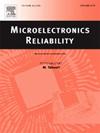Simulation study on the effect of palladium layer thickness and temperature on the bonding properties of palladium coated copper wire
IF 1.6
4区 工程技术
Q3 ENGINEERING, ELECTRICAL & ELECTRONIC
引用次数: 0
Abstract
Palladium coated copper (PCC) wire is an emerging bonding wire. There are relatively few studies on the effect of palladium plating thickness and temperature on its bonding performance. In order to investigate the effects of three parameters, namely palladium plating thickness, chip preheating temperature and the free air ball (FAB) initial temperature, on the bonding performance of PCC wires, this paper establishes a transient nonlinear finite element analysis model of thermal coupling between bare copper wires and PCC wires, and simplifies the whole bonding process into two stages of impact and ultrasonic vibration to carry out the experimental simulation. Firstly, the Taguchi orthogonal test method was adopted to obtain the ranking of the degree of influence of the three factors on the bonding results, and the optimum palladium plating thickness and FAB initial temperature of 100 nm and 100 °C were derived, respectively. Then the PCC wires with 100 nm palladium plating thickness were selected, and the bare copper wires were used as the reference, and multiple one-factor simulation experiments were carried out under the condition of changing the chip preheating temperature only. The simulation results show that the FAB and pad stress levels in the bonding results of the PCC wires are significantly higher than those of the bare copper wires, but the GaN layer stress is less than that of the bare copper wires. Moreover, there is an approximate parabolic relationship between the maximum stresses of pad and GaN layer and the preheating temperature of the chip. In the bonding results of bare copper wire, there is also an approximate parabolic relationship between the maximum stress of FAB and the chip preheating temperature. This parabolic relationship allows a prediction of the optimum chip preheating temperature. Selecting the appropriate palladium plating thickness and controlling the appropriate FAB temperature and chip preheating temperature can improve the bonding quality, and this numerical simulation work can provide a reference for the selection of palladium plating thickness and temperature parameter regulation of PCC wires.
钯层厚度和温度对镀钯铜线键合性能影响的模拟研究
镀钯铜线(PCC)是一种新兴的键合线。关于镀钯厚度和温度对其键合性能影响的研究相对较少。为了研究镀钯厚度、芯片预热温度和自由空气球(FAB)初始温度这三个参数对 PCC 线键合性能的影响,本文建立了裸铜线与 PCC 线热耦合的瞬态非线性有限元分析模型,并将整个键合过程简化为冲击和超声振动两个阶段,进行了实验模拟。首先,采用田口正交试验法得出三个因素对键合结果影响程度的排序,分别得出最佳镀钯厚度和 FAB 初始温度为 100 nm 和 100 ℃。然后选择镀钯厚度为 100 nm 的 PCC 线,以裸铜线为参考,在仅改变芯片预热温度的条件下进行了多次单因素模拟实验。仿真结果表明,PCC 线键合结果中的 FAB 和焊盘应力水平明显高于裸铜线,但 GaN 层应力小于裸铜线。此外,焊盘和 GaN 层的最大应力与芯片的预热温度之间存在近似抛物线的关系。在裸铜线的键合结果中,FAB 的最大应力与芯片预热温度之间也存在近似抛物线关系。通过这种抛物线关系可以预测芯片预热的最佳温度。选择合适的镀钯厚度、控制合适的 FAB 温度和芯片预热温度可以提高键合质量,而这一数值模拟工作可以为 PCC 线镀钯厚度的选择和温度参数的调节提供参考。
本文章由计算机程序翻译,如有差异,请以英文原文为准。
求助全文
约1分钟内获得全文
求助全文
来源期刊

Microelectronics Reliability
工程技术-工程:电子与电气
CiteScore
3.30
自引率
12.50%
发文量
342
审稿时长
68 days
期刊介绍:
Microelectronics Reliability, is dedicated to disseminating the latest research results and related information on the reliability of microelectronic devices, circuits and systems, from materials, process and manufacturing, to design, testing and operation. The coverage of the journal includes the following topics: measurement, understanding and analysis; evaluation and prediction; modelling and simulation; methodologies and mitigation. Papers which combine reliability with other important areas of microelectronics engineering, such as design, fabrication, integration, testing, and field operation will also be welcome, and practical papers reporting case studies in the field and specific application domains are particularly encouraged.
Most accepted papers will be published as Research Papers, describing significant advances and completed work. Papers reviewing important developing topics of general interest may be accepted for publication as Review Papers. Urgent communications of a more preliminary nature and short reports on completed practical work of current interest may be considered for publication as Research Notes. All contributions are subject to peer review by leading experts in the field.
 求助内容:
求助内容: 应助结果提醒方式:
应助结果提醒方式:


